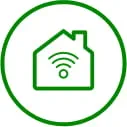At a time when digital connectivity is a necessity, the digital divide between urban and rural communities in terms of internet access has become a pressing issue. One way to help bridge that divide is through the expansion of fiber internet service to rural communities. While installing fiber internet to those communities can be challenging, the potential benefits it offers to people living in those communities far outweigh any of those challenges.
Understanding the digital divide
Before delving into the importance of bringing fiber internet to rural communities, it’s important to understand the concept of the digital divide and what drives it. The term “digital divide” refers to the inequality of internet access and usage between different demographic groups or geographical areas. This divide is rooted in various factors, including economic status, location, education and infrastructure. While urban areas typically enjoy high-speed internet connectivity, rural regions often struggle with limited access due to the high cost and logistical challenges associated with providing internet services in less densely populated areas.
What makes fiber internet so unique? Often referred to as “future-proof” technology, fiber internet uses thin strands of glass to transmit data using pulses of light. This method enables significantly faster data transmission compared to traditional copper-based connections like DSL or cable. However, the benefits of fiber internet extend beyond just speed:
- Reliability: Fiber-optic cables are less susceptible to environmental factors like weather and electromagnetic interference, which often affects copper-based cables. This results in a more stable and consistent connection.
- Symmetrical upload and download speeds: Unlike many other types of connections, fiber internet provides equal upload and download speeds. This means that data travels at the same speed in both directions, leading to less lag. This is crucial for activities like video conferencing, cloud computing and online collaboration.
- Scalability: Fiber's immense bandwidth capacity means it can accommodate future technological advancements and increasing data demands without requiring significant infrastructure upgrades — hence the term “future-proof.”
Why does it take so long to bring fiber internet to rural areas?
While the advantages of bringing fiber internet to rural communities are clear, it’s not without its challenges:
-
Infrastructure costs: Rural areas typically lack the existing infrastructure needed for fiber deployment. Digging trenches, laying fiber-optic cables and setting up network equipment can incur substantial costs.
- Geographical challenges: Rural landscapes can be rugged and topographically diverse, making the laying of cables more complex and time-consuming.
- Low population density: The lower population density in rural areas can make the return on investment for internet service providers (ISPs) less attractive, leading to hesitation in undertaking such projects.
- Regulatory hurdles: Navigating regulatory approvals and permits for network deployment can be cumbersome and time intensive.
- Community awareness: Some rural residents might not be fully aware of the benefits of fiber internet, leading to potential resistance or lack of demand.
The current state of fiber internet in the United States
The expansion of fiber internet access in the United States has been a gradual process. While urban and suburban areas have witnessed significant growth in fiber internet availability, progress in rural areas has lagged. According to data from the Federal Communication s Commission (FCC), about 29% of rural Americans lack access to broadband internet, and a significant portion of those with access have slower, less reliable connections. However, there has been a concerted effort to rectify the situation.
Internet service providers like Ziply Fiber and government initiatives have been working to extend fiber infrastructure to underserved regions. The FCC's Rural Digital Opportunity Fund (RDOF), for instance, allocates billions of dollars to support the expansion of broadband services, including fiber, to rural areas.
Current solutions and initiatives
The federal government has several programs aimed at accelerating broadband deployment in rural areas. For instance, the FCC’s Rural Digital Opportunity Fund (RDOF) allocates billions of dollars to ISPs to build high-speed networks in underserved communities. Similarly, the Infrastructure Investment and Jobs Act earmarks substantial funds specifically for expanding fiber infrastructure in rural regions.
State-level programs
Many states have their own broadband initiatives to complement federal efforts. Programs such as the Washington State Broadband Office’s Grant Program and Oregon’s Rural Broadband Capacity Program provide direct funding to local ISPs and municipalities to bridge the digital divide.
Rural Utilities Service (RUS) Programs
The USDA’s Rural Utilities Service offers loans and grants through initiatives like the ReConnect Program, aimed at financing the construction and improvement of broadband service in rural areas. These programs emphasize not only access but also affordability for rural residents.
Private sector solutions
Major telecom provider initiatives
Large telecom companies have made significant investments in rural broadband through initiatives like fixed wireless and fiber expansions. These efforts are often supported by government funding programs.
Local and regional ISP efforts
Smaller, community-focused ISPs like Ziply Fiber are playing a crucial role in rural fiber deployment. By leveraging local knowledge and focusing on underserved areas, we often deliver faster and more reliable services tailored to specific community needs.
Public-private partnerships
Collaborations between government entities and private companies are increasingly common. For example, partnerships like those seen in Idaho pair state funding with the technical expertise of ISPs to deliver broadband solutions more efficiently.
Cooperative models
Rural electric cooperatives, such as the ones operating in the Midwest, are expanding their mission to include broadband services. By utilizing existing infrastructure, they’re able to lower costs and accelerate deployment timelines.
Implementation strategies
Community needs assessment
Understanding the unique requirements of a community is the first step. This involves collecting input from residents, businesses and local governments to identify priorities and pain points.
Geographic and demographic analysis
Detailed mapping and analysis help pinpoint areas with the greatest need for fiber investment. Factors such as population density and existing infrastructure are critical considerations.
Cost-benefit analysis
Analyzing potential economic and social benefits helps prioritize investments and ensures that funds are used effectively.
Technical feasibility studies
These studies assess the practicality of deploying fiber in specific areas, considering factors like terrain and existing infrastructure.
Environmental impact considerations
Fiber deployments must comply with environmental regulations. Impact studies help ensure that projects are both sustainable and compliant.
Case study
Snohomish County, Washington
In Snohomish County, we worked with the local government in order to expand fiber coverage, connecting thousands of rural residents to high-speed internet. Read the full story here.
Economic and social impact
Access to high-speed internet enables rural businesses to expand their markets, attract investment and drive local economic growth.
Educational benefits
Fiber internet supports distance learning, providing students in rural areas with the same opportunities as their urban counterparts.
Healthcare improvements (Telehealth)
Telehealth services become feasible and effective with reliable broadband, giving rural residents access to specialists and critical care.
Agricultural technology advancement
Smart farming techniques, reliant on IoT devices, benefit significantly from fiber connectivity, improving efficiency and yields.
Remote work possibilities
Reliable internet allows rural residents to participate in the remote workforce, reducing the need for urban migration and supporting local economies.
Property value implications
Homes with high-speed internet access tend to see higher property values, benefiting homeowners and attracting new residents to rural areas.
When will fiber internet be available in your area?
Expanding fiber internet service to rural communities is a critical step toward bridging the digital divide, which will enable those communities to improve digital literacy, invest in digital education and provide access to job opportunities. Ziply Fiber is leading the charge in the Northwest, working hard every day with city governments and community leaders in Washington, Oregon, Idaho and Montana to help create a more equitable digital landscape for all .
Ziply Fiber offers the fastest home internet in the Northwest. Whether you want to stream your favorite online content, experience seamless video conferencing or attend online classes with a consistent, dependable connection, Ziply Fiber is here to provide you with an exceptional internet experience.
Learn more about Ziply Fiber and find out if we’re in your area or coming soon.






